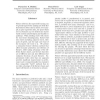104 search results - page 15 / 21 » Word Sense Disambiguation by Relative Selection |
LREC
2010
13 years 8 months ago
2010
Conventional methods for disambiguation problems have been using statistical methods with co-occurrence of words in their contexts. It seems that human-beings assign appropriate w...
EMNLP
2009
13 years 5 months ago
2009
This paper presents a supervised method for resolving metonymies. We enhance a commonly used feature set with features extracted based on collocation information from corpora, gen...
ACL
2003
13 years 8 months ago
2003
We present a supervised machine learning algorithm for metonymy resolution, which exploits the similarity between examples of conventional metonymy. We show that syntactic head-mo...
JMLR
2010
13 years 2 months ago
2010
Feature selection for supervised learning can be greatly improved by making use of the fact that features often come in classes. For example, in gene expression data, the genes wh...
ECML
2003
Springer
14 years 17 days ago
2003
Springer
Comparative machine learning experiments have become an important methodology in empirical approaches to natural language processing (i) to investigate which machine learning algor...

